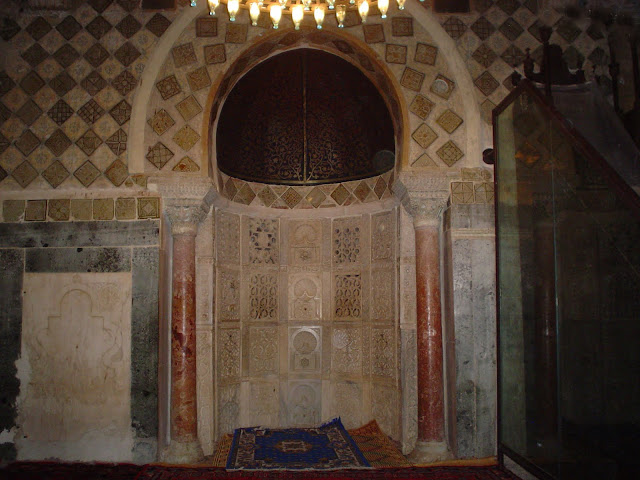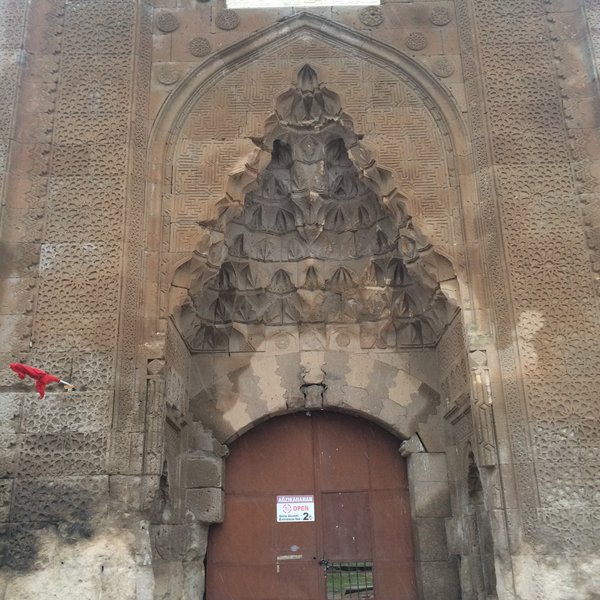 |
| Achaemenid rosette, 500-400 BC, Tehran |
Islamic architectural art during the early Abbasid period presents an adult, rich and conscious language full of consequences for the centuries to come.
Seljuk art in Anatolia, Iran and partly Central Asia sum up and codify many features of it and offers
a safe reference so far for the history of carpet designs, once pointed to its complex origin.
And commonly, Seljuk decorative heritage is to be seen in Anatolian carpets centuries later.
The 'rosette' woven in the niche spandrels is the case at point here.
The generic term does not refer to a realistically depicted flower yet to a device stressing a specific point in a pattern. Weavers were usually able to depict flowers although stylised. In some cases they wove geometrically inspired motifs, instead.
Architecture looks like to be a major source of inspiration. Mihrabs and doorways of important royal buildings (mosque, caravanseray, school, mausoleum) in all the Islam-influenced regions sport the use of two discs flanking the arch vault from the Mediterranean shores to the Indian area.
How this feature found its way into Islamic architecture is not clear.
Al Walid I, the sixth Umayyad caliph reigning 705-715, is reputed for the powerful insight of architecture as a cultural propaganda means. He is credited to have initiated the Great Mosque of Damask, the Al Aqsa in Jerusalem and the Prophet's in Medina. But witness of the two discs in a mihrab are found only somewhat later in two marble panels: one in the Great Mosque of Qairouan, Aghlabid period 9th, the second in the cave of the Al Aqsa mosque, 9th (Whelan).
Probably a late classic use of spandrel bosses instilled the usage as in a Tulunid example in Egypt, and obviously in Aghia Sophia in Istanbul.
The marble panel flanking the mihrab in Qairouan is reputedly dated 862-875 as well as the upper mihrab vault decoration where again miniature mihrab and rosette are matched.
 |
| Qairouan mosque, 9th marble panel aside the mihrab |
 |
| Qairouan detail |
 |
| Marble mihrab, Al Aqsa's cave, 9th |
 |
| Aghia Sophia, marble bosses within arches, Istanbul |
 |
| Ibn Tulun mosque, 9th/10th Cairo, round bosses |
Further east in the Samanid mausoleum of Bukhara, 892-943.
🍀Seljuk architecture developed them with its proper geometric interlacements.
 |
| Beyekhim mosque mihrab, Konya circa 1270 , Museum of Islamic Art Berlin |
 |
| Esrefoglu mosque, mihrab, Beyshehir Anatolia 13th |
 |
| Gok Medrese, Amasya, Anatolia, 13th 2nd half |
 |
| Seljuk Iran, Moya Carey's Instagram photocredits |
In addition, a single such element stands over the mihrab or shines amids inscriptions, nearly a sacred, superimposing presence. Floral interlacements are soon introduced.
 |
| Mihrab in Sultan Hassan mosque, mid 14th, Cairo |
 |
| Arslanhane mosque (1290-1330), mihrab Ankara |
🍀The two discs have been interpreted as the moon and the sun.
There are actually some lines in the Quran that seemingly confirm this interpretation.
sura 25, verse 61:
"Blessed is the One Who placed the constellations in heaven and placed therein a lamp and a moon giving light."--
sura 71, 15-16:
"Did you see how God created seven heavens one above an other and made the moon a light therein and made the sun a lamp".
Quran 6:97
"And it is He who ordained the stars for you that you may be guided thereby in the darkness of the land and the sea"
The two discs might be the sun and moon, but also the stars (curiously they are often inscribed with a star). The stars are reflections of the glory of the creator, the organising principle of all the stellar and planetary systems.
Allah is the true light of the heavens and the earth. This supreme light is also called the Light of the Prophet since he is the created being who received the major quantity of it to the point that Allah calls him in the Qur’ān “an illuminating lamp”. Consequently, a single disc/rosette in preeminent place may refer to both, Allah or Muhammad.
Interestingly, rosettes are depicted also in sacred scripts to help the reader (and guide him throughout the deep darkness of the divine words)
Quran's folio, 13th-14th c. Spain, the Metropolitan Museum
|
Not only an Islamic usage
 |
| Leningrad Codex, 1008 |
Stars in fact are lamps in the night sky. From Cairo comes the meme of a star replacing the light of the lamp. Depictions of interlaced stars (medallions) within a niche will be common in early Anatolian carpets
 |
| Mihrab, pre-Fatimid Ibn Tulun mosque, Cairo |
 |
| Saph carpet, Anatolia, 15th, TIEM |
And Stars seem indeed to be interchangeable with the Sun and Moon motif in the architectural language.
 |
| Gok medresse, Sivas, 1271 |
A subliminal reference to the person of the Prophet via the rosettes is pointed out by Whelan in her analysis of the designs in the Jeruslamen cave mihrab. The spear-like forms upsidedown supposedly represent the aznah, the spear that Muhammad used to have planted on the ground to indicate the qiblah and to serve as a boundary for his praying space (E. Whelan, The Origins of the Mihrab Mujawwaf, p. 214,215).
The unadorned Jerusalem rosette foresees way later examples created by the weaver's unfettered imagination (Ralph Kaffel, Hali autumn 2008).
 |
| Niche carpet, Central anatolia, circa 1800, published Alberto Levi Textile Art 1, 2000 |
🍀The carpet tradition more attached to this architectural element looks like to be that of the Anatolian prayer rug. In Mamluk Egypt there exists only one now residing in Berlin, dated to circa 1500. The spandrels incrusted with an allover tracery present two octagonal star medallions of the so called 'Crivelli' type.
No trace of the device in Iranian/Safavid creations so far.
Ottoman exemplars do not sport it in favour of a floral decoration which can vary from arabesque to diverse floral arrangements following decorative patterns on fashion in the period.
Real rosette was indeed one of the main beloved botanical species.
🍀Quite curiously, rosettes appear primarily in a unique family of antique Anatolian rugs, the so called Transylvanian. And, mainly in one subgroup: the double-niche type (S. Ionescu, Antique Ottoman Rugs in Transylvania, 2006).
Matched with a serrated leaf on the vault apex the rosette creates a formulaic pattern. Rarely, it occurs in other formats (idem cat 148). It does not in the single stepped niche type where favoured is the carnation and serrated motif.
The distribution and combination of decorative sets in Transylvanian rugs do apply rules created for the carpets while instilled by the diverse decoration of real mihrabs (not always the two discs are represented). Safely it can be said that as weavers wanted to knot flowers they were able to do. O the other hand the rosettes geometrically depicted strongly recall those above addressed to.
The famed 1610 edict by Sultan Ahmed forbidding religious designs in carpets destined to unbeliever commissioners would not relate to them nor to lamp and arch as they are motifs shared with other cultures.
Along the 17th century the 'rosette' appears as an octagon with a leafy irregular frame, inscribed with a geometric layout, while architectural mihrabs persevered to depict them undisturbed.
In the meantime realistic floral spandrels do abound in Transylvanian carpets .

The astral discs heritage enjoyed a long karstic life in genuine Anatolian village rugs moving for the loyalty to ancient traditions. The outer border of the carpet below is again a Seljuk design.
Bibliography
A. J. Lee, 'Islamic Star Patterns'. Muqarnas 4, E. J. Brill, Leiden, 1987
Tony Lee & Ayman Soliman, Geometric Rosette : analysis of an Islamic decorative motif, August/September, 2014
E. Whelan, The Origins of the Mihrab Mujawwaf: A Reinterpretation, Cambridge University Press 1986.
E. Baer, The Mihrab in the Cave of the Dome of the Rock, Muqarnas 1985
A. Fotheringham, A Warrior's Magic Shirt, V&A blog
O. Felek, Fears Hopes and Dreams: The Talismanic Shirts of Muhrad III, Brill 2017
S. Ionescu, Antque Ottoman Rugs in Transylvania 2006
R. Ettinghausen, The Early History, Use and Iconography of the Prayer Rug 1984
R. Kaffel, Unusually Anatolian, Hali Autumn 2008
No trace of the device in Iranian/Safavid creations so far.
 |
| Niche carpet, Mamluk Egypt, circa 1500 Museum for Islamic Art Berlin |
Ottoman exemplars do not sport it in favour of a floral decoration which can vary from arabesque to diverse floral arrangements following decorative patterns on fashion in the period.
 |
| Cairene-Ottoman niche carpet, second half 16th, MAK Vienna |
Real rosette was indeed one of the main beloved botanical species.
 |
| Iznik tile niche panel, III quarter of the 16th, the David Collection |
🍀Quite curiously, rosettes appear primarily in a unique family of antique Anatolian rugs, the so called Transylvanian. And, mainly in one subgroup: the double-niche type (S. Ionescu, Antique Ottoman Rugs in Transylvania, 2006).
Matched with a serrated leaf on the vault apex the rosette creates a formulaic pattern. Rarely, it occurs in other formats (idem cat 148). It does not in the single stepped niche type where favoured is the carnation and serrated motif.
The distribution and combination of decorative sets in Transylvanian rugs do apply rules created for the carpets while instilled by the diverse decoration of real mihrabs (not always the two discs are represented). Safely it can be said that as weavers wanted to knot flowers they were able to do. O the other hand the rosettes geometrically depicted strongly recall those above addressed to.
The famed 1610 edict by Sultan Ahmed forbidding religious designs in carpets destined to unbeliever commissioners would not relate to them nor to lamp and arch as they are motifs shared with other cultures.
Along the 17th century the 'rosette' appears as an octagon with a leafy irregular frame, inscribed with a geometric layout, while architectural mihrabs persevered to depict them undisturbed.
 |
| Double niche Transylvanian carpet, Anatolia 17th 2nd half, Sibiu, Hali photocredits |
 |
| Double niche Transylvanian carpet with medallion, Anatolia, 17th 2nd half, Ambassador Berry collection |
 |
| Single niche Transylvanian carpet, Anatolia 17th 1st half, Madrid Instituto de Valencia de Don Juan |
In the meantime realistic floral spandrels do abound in Transylvanian carpets .

 |
| Niche Transylvanian carpet, 17th Anatolia, Sothebys photocredits |
 |
| Niche Transylvanian carpet, 17th/18th, Hali archive |
 |
| Iznik tile panel, Rustem Pasha mosque Istanbul |
The astral discs heritage enjoyed a long karstic life in genuine Anatolian village rugs moving for the loyalty to ancient traditions. The outer border of the carpet below is again a Seljuk design.
| Anatolian niche carpet with re-entry, Sothebys photocredits via rugtracker.com |
 |
| Torumtay mausoleum, 1271, Amasya |
Bibliography
A. J. Lee, 'Islamic Star Patterns'. Muqarnas 4, E. J. Brill, Leiden, 1987
Tony Lee & Ayman Soliman, Geometric Rosette : analysis of an Islamic decorative motif, August/September, 2014
E. Whelan, The Origins of the Mihrab Mujawwaf: A Reinterpretation, Cambridge University Press 1986.
E. Baer, The Mihrab in the Cave of the Dome of the Rock, Muqarnas 1985
A. Fotheringham, A Warrior's Magic Shirt, V&A blog
O. Felek, Fears Hopes and Dreams: The Talismanic Shirts of Muhrad III, Brill 2017
S. Ionescu, Antque Ottoman Rugs in Transylvania 2006
R. Ettinghausen, The Early History, Use and Iconography of the Prayer Rug 1984
R. Kaffel, Unusually Anatolian, Hali Autumn 2008
























